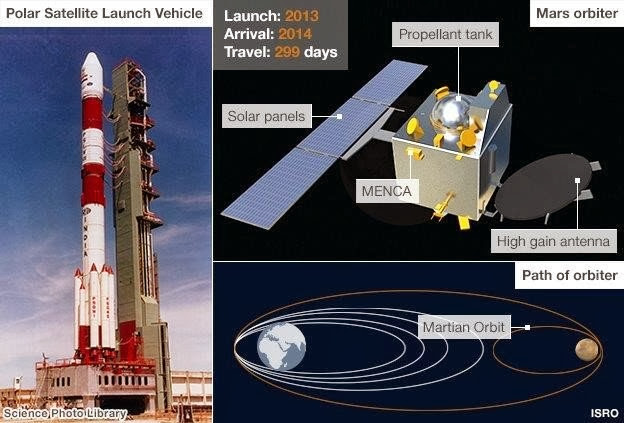Tuesday, November 5, 2013
Wow MOM goes India! Mission Mars how big a leap is it really for India?
After India's successful unmanned Chandrayaan mission to the Moon in 2008 that brought back the first clinching evidence of the presence of water there, the Mars mission, according to K Radhakrishnan, chairman of the Indian Space Research Organisation (Isro), is a "natural progression."
The last updates from ISRO informed – All subsystems of ISRO's Mars Orbiter Mission (MOM) spacecraft have been Powered ON in orbit. Health of the spacecraft is confirmed normal. Solar Panel and Reflector deployments have been completed successfully. Spacecraft has achieved the first orbit of 246.9 by 23,566.69 km around Earth.
India's 1,350kg (2,976lb) robotic satellite which is undertaking the 10-month-long, over 200-million-kilometre journey to Mars is equipped with five instruments.
They include a sensor to track methane or marsh gas - a possible sign of life - on Mars, a colour camera for taking pictures, and a thermal imaging spectrometer to map the surface and mineral wealth of the planet. The mission will also analyse the thin Martian atmosphere.
Is this about a sense of achievement?
China has beaten India in space in almost every aspect so far: it has rockets that can lift four times more weight than India's, and in 2003, successfully launched its first human space flight which India has not yet embarked on. China launched its maiden mission to the Moon in 2007, ahead of India, as reported in BBC.
BBC further reports - India sees the MOM as an opportunity to beat its regional rival China in reaching the planet, especially after a Russian mission carrying the first Chinese satellite to Mars failed in November 2011. Japan also failed in a similar effort in 1998.
Space Odyssey is long way home!
The Hindu reported -
The successful launch of the country’s Mars Orbiter Mission (MOM) on Tuesday, is only part of the country’s first inter-planetary venture story. The space odyssey is long and complex.
The Indian Space Research Organisation (ISRO) is now looking forward to two key dates — December 1, 2013 when the MOM spacecraft leaves the earth’s sphere of influence and September 24 next year, when it’s captured by Martian orbit.
The spacecraft launched on Tuesday would go around the earth for 25 days before the ISRO plans to do trans-Mars injection at 0.42 hours on December 1 enabling it to undertake the long voyage towards the Red planet.
“This injection has to be precise as it will estimate where the satellite would be on September 24, 2014 — plus or minus 50 kms from the designated orbit around Mars (366 kms X 80,000 kms),” an ISRO official told PTI.
As the spacecraft approaches the Martian orbit, ISRO would reduce the velocity so that it’s captured by Martian orbit; otherwise if it continues with the same velocity, it would fly past Mars.
“Being a complex mission of this nature, any day you advance (of the 300-day journey from earth to Mars), it’s a progress,” ISRO Chairman K. Radhakrishnan said.
ISRO has incorporated autonomous features in MOM spacecraft to handle contingencies.
“As it moves towards Mars, given the distance between Mars and earth, you will encounter communication delay 20 minutes one way. It means when signals are sent from ground stations, it will take 20 minutes to reach the spacecraft. For about 40 minutes (including time for return communication), there will be a occasion when you do not know what’s happening,” an ISRO official said.
Autonomous features would ensure that the craft takes its own decisions until commands are sent from the ground — in case of malfunction, it would switch over to redundant systems and on occasions, goes into the safe mode, turning its antenna towards earth and solar panels toward sun to build up optimum power, the official explained.
Friday, November 1, 2013
In a first, US Woman gets ticket for wearing Google Glass. A good precedent?
If talking over the phone is an offense, certainly wearing Google Glass and driving should come under the same rule of law.
In what would set a precedent for the futuristic a woman was pulled over by a San Diego cop for speeding, and ticketed for wearing Google Glass.
Cecilia Abadie, a software developer, told The Associated Press that she was not using her Google Glass when she was pulled over.It's unclear whether a citation for Google Glass has been issued before.Abadie said she is surprised that wearing the glasses would be illegal and that she's "pretty sure" she will fight the ticket."The law is not clear, the laws are very outdated," Abadie said, suggesting that navigating with the device could be less distracting than with a GPS device or phone.
The eyeglasses, which are not yet widely available to the public, feature a hidden computer and a thumbnail-size transparent display screen above the right eye. Users can scan maps for directions -- as well as receive web search results, read email and engage in video chats -- without reaching for a smartphone.
While the issue has certain racked up a furious debate, it goes without saying that 'using Google Glass while driving certainly should come under the purview of the law.' A technology is meant to assist us and not to hinder.
Can anybody assure that somebody using the Google Glass is doing a responsible thing,while doing so driving?
Cecilia Abadie may be all in her rights to challenge the 'ticket' but News It Is firmly supports the fact that devices such as Google Glass or a mobile phone can not be held above the life of another road user and if for that one time when you got distracted !
As of now the Legislators in Delaware, New Jersey and West Virginia have already introduced bills that would ban driving with Google Glass. And the officer who issued the ticket should actually be congratulated, for standing his ground and setting a precedent.
Subscribe to:
Comments (Atom)

